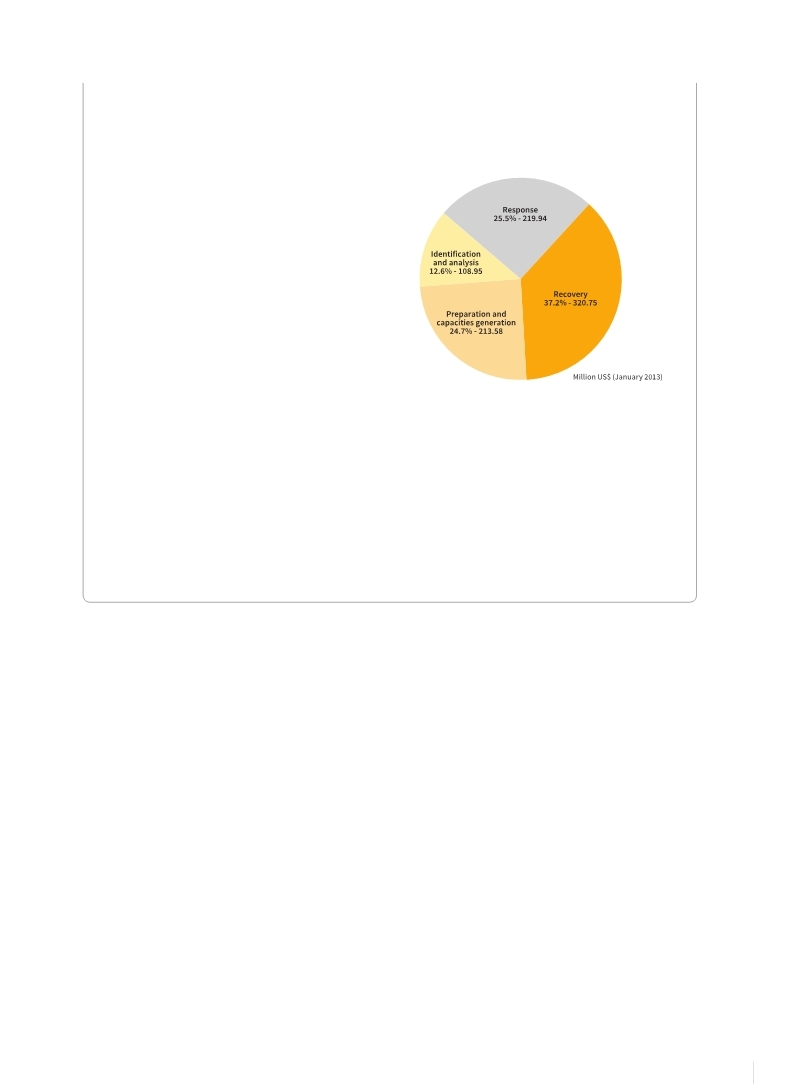 |
Global Assessment Report on Disaster Risk Reduction 2013
From Shared Risk to Shared Value: the Business Case for Disaster Risk Reduction |
 |
Global Assessment Report on Disaster Risk Reduction 2013
From Shared Risk to Shared Value: the Business Case for Disaster Risk Reduction |
|
|


|

220 Part III - Chapter 14
ture on disaster risk reduction is growing.
Some countries are now skewing their budget allocations in favour of investments in corrective disaster risk management and strengthening financial resilience (see Annex 3), often through the establishment of dedicated funds and budget lines, during post-disaster recovery or when faced with imminent events.
For example, the HFA Monitor 2011–2013 highlights that in Sri Lanka, 60 percent of the Ministry of Disaster Management’s annual allocation is dedicated to corrective disaster reduction projects. In 2012, Sweden allocated US$60 million for disaster reduction in the transport sector. Japan’s 2012 disaster management budget is US$46 billion, of which
US$6.4 billion is allocated to disaster prevention management and US$9.5 billion to national land conservation. In Australia, the National Partnership Agreement on Natural Disaster Resilience (NPA) provides state governments with approximately US$27 million per year to invest in disaster risk reduction projects prioritised in accordance with state-wide risk assessments complementing private sector investments.
The Government of Canada allocated almost US$100 million in its 2012 Budget to share the cost of permanent flood mitigation investments made by provinces and territories affected by spring floods in 2011. In addition, the Building Canada programme, administered by Infrastructure Canada, seeks to create a more competitive and prosperous
In Guatemala, as Figure 14.7 below shows, the Guatemalan Ministry of Finance has developed a tool to code its expenditure in four categories: risk identification and analysis; preparation and capacity building; disaster response; and disaster recovery. None of these categories explicitly identify strategies of either corrective or prospective risk management although related activities could be embedded within these, particularly in identification and analysis, recovery and capacity building.
Figure 14.7 Guatemala disaster risk management expenditure in 2010
(Source: UNISDR)
In Panama, the Directorate of Investment Planning (DPI) estimated government expenditures on disaster prevention, mitigation, response and reconstruction over the last decade. Using similar categories as Guatemala’s tracking system, total calculations amounted to about US$200 million for 2000 to 2010 (  Orihuela, 2012 Orihuela, 2012 Orihuela, J.C. 2012.,Understanding Existing Methodologies for Allocating and Tracking DRR Resources in 6 Countries in the Americas: Colombia, Costa Rica, Guatemala, Mexico, Panama and Peru., Study commissioned by UNISDR., Geneva,Switzerland: UNISDR.. Orihuela, J.C. 2012.,Understanding Existing Methodologies for Allocating and Tracking DRR Resources in 6 Countries in the Americas: Colombia, Costa Rica, Guatemala, Mexico, Panama and Peru., Study commissioned by UNISDR., Geneva,Switzerland: UNISDR.. Click here to view this GAR paper. In Mexico, the government, with support from the World Bank, has initiated assessment and monitoring of public investments in disaster risk reduction xi at the federal level.x The project will analyse investments; the use of hazard and risk information in federal decision-making for disaster risk reduction; and the impacts of investment through sectoral case studies. It will also develop a mechanism to follow up and better monitor future investments in disaster risk reductionxi (Source:
 Orihuela, 2012 Orihuela, 2012 Orihuela, J.C. 2012.,Understanding Existing Methodologies for Allocating and Tracking DRR Resources in 6 Countries in the Americas: Colombia, Costa Rica, Guatemala, Mexico, Panama and Peru., Study commissioned by UNISDR., Geneva,Switzerland: UNISDR.. Orihuela, J.C. 2012.,Understanding Existing Methodologies for Allocating and Tracking DRR Resources in 6 Countries in the Americas: Colombia, Costa Rica, Guatemala, Mexico, Panama and Peru., Study commissioned by UNISDR., Geneva,Switzerland: UNISDR.. Click here to view this GAR paper. |



 |
